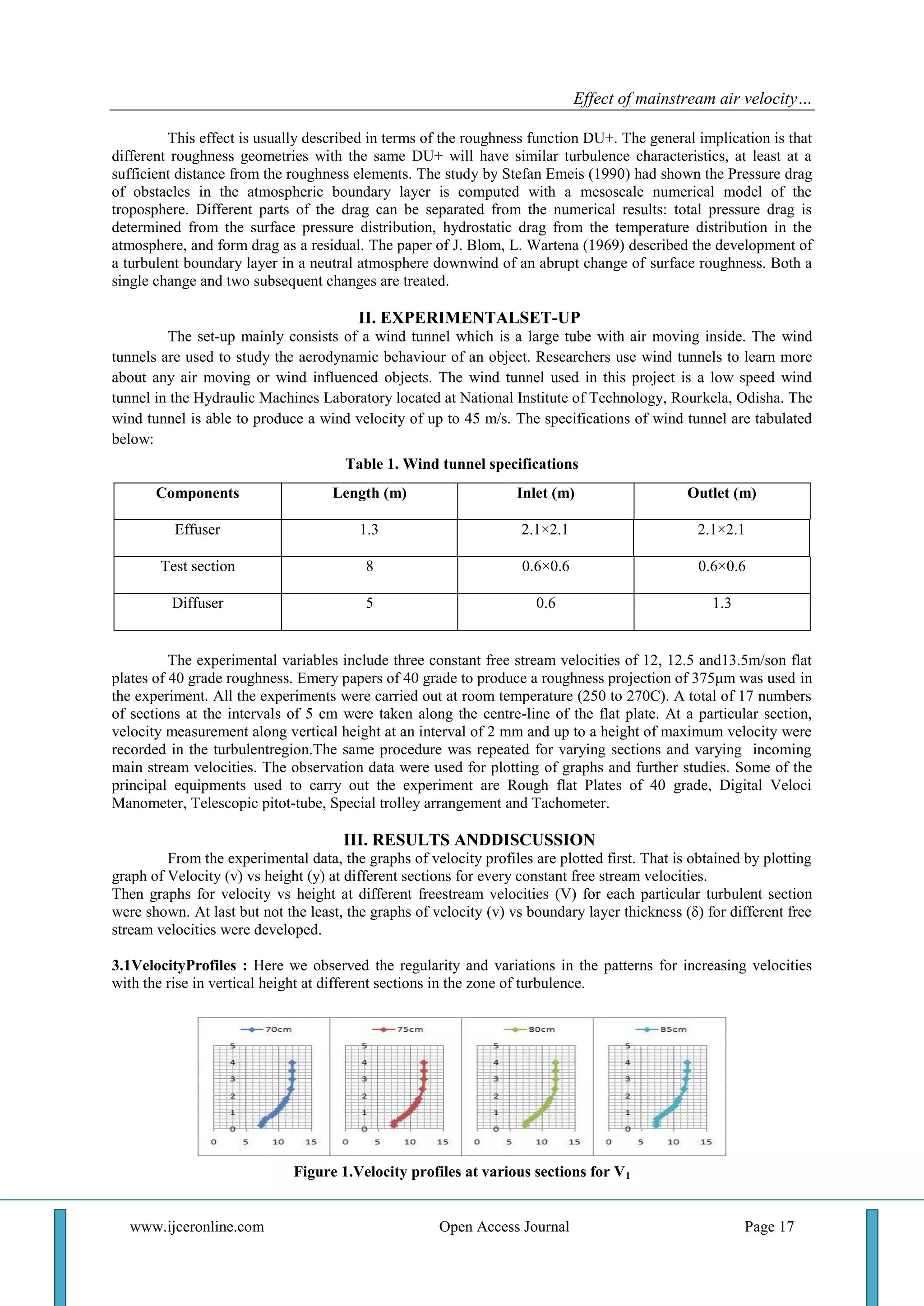1) The document discusses an experiment that measured the velocity profile over a rough flat surface at different locations along the surface (sections) and with varying mainstream air velocities.
2) The results showed that at a given location, velocity increased with increasing mainstream velocity. Additionally, boundary layer thickness increased with distance from the leading edge but decreased with increasing mainstream velocity.
3) In conclusion, the velocity over the rough surface was significantly influenced by the incoming air velocity, and boundary layer thickness varied inversely with mainstream velocity but directly with distance from the leading edge.



![Effect of mainstream air velocity…
www.ijceronline.com Open Access Journal Page 19
3.3Plot of Boundary Layer Thicknesses at Different Sections for All the Free Stream Velocities & Vice-
Versa
Figure 8.Plot of boundary layer thicknesses at turbulent sections for different free stream velocities.
IV. CONCLUSION
From the analysis of the experimental data and plots, it has been concluded that at a particular location,
the velocity is significantly influenced by the incoming free stream velocity. It has been obtained that velocity at a
given location above the surface increases with increase in mainstream velocity. Again, it has been found that for
a given mainstream velocity, boundary layer thickness increases as the distance from the leading edge increases.
Also, it is has been concluded that at a particular section, the boundary layer thickness decreases with increase in
mainstream velocity.
REFERENCES
[1]. K. V. S. Namboodiri, Dileep Puthillam Krishnan, et al. (2014) “Coastal Boundary Layer Characteristics of Wind, Turbulence,
and Surface Roughness Parameter over the Thumba Equatorial Rocket Launching Station”, Journal of Climatology.Volume
2014, Article ID 504178, 21 pages.
[2]. James Cardillo & Yi Chen (2013) “DNS of a turbulent boundary layer with surface roughness”. Journal of Fluid Mechanics/
Volume 729 /, pp 603-637 Cambridge University Press.
[3]. Hedenström, Anders, et al. (2009) “High-speed stereo DPIV measurement of wakes of two bat species flying freely in a wind
tunnel." Experiments in Fluids 46.5: 923-932.
[4]. Klipp, Cheryl (2007), "Wind direction dependence of atmospheric boundary layer turbulence parameters in the urban roughness
sublayer." Journal of Applied Meteorology and Climatology 46.12: 2086-2097.
[5]. B. Massey and J. Ward-Smith,(2006) "Mechanics of Fluids", Taylor and Francis, 8th Edition.
[6]. Cao, Shuyang, and Tetsuro Tamura. (2006), "Experimental study on roughness effects on turbulent boundary layer flow over a
two-dimensional steep hill." Journal of wind engineering and industrial aerodynamics 94.1 (2006): 1-19.
[7]. Aubertine, Carolyn D., John K. Eaton, et al. (2004) "Parameters controlling roughness effects in a separating boundary layer."
International journal of heat and fluid flow 25.3 (2004): 444-450.
[8]. F.M. White, (2003) "Fluid Mechanics", McGraw-Hill, 5th Edition.
[9]. B.R. Munson, D.F. Young, et al. (2002), "Fundamentals of Fluid Mechanics", John Wiley, 4th Edition.
[10]. Blom, J., and L. Wartena. (1969) "The influence of changes in surface roughness on the development of the turbulent boundary
layer in the lower layers of the atmosphere." Journal of the Atmospheric Sciences 26.2 (1969): 255-265.](https://image.slidesharecdn.com/c052016019-150309004341-conversion-gate01/75/Effect-of-mainstream-air-velocity-on-velocity-profile-over-a-rough-flat-surface-4-2048.jpg)